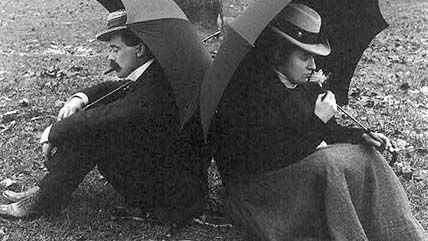Umbrellas: The iPhones of the Victorian Age
New technologies help create a sense of personal privacy in public.

Big cities are great places if you're looking for work, stimulation, love, or a new life. But the density that fosters excitement and opportunity also erodes security and identity. Amid the crush of strangers, a single person can feel violated or insignificant. So city dwellers are quick to adopt any technology suitable for carving out personal space in public.
Before the smartphone or the hoodie, the iPod or the Walkman—even before the automobile—that technology was the umbrella. It gave its bearer space and a semblance of privacy. Like the smartphone and the music player, it also provided ample material for humorists, social critics, and arbiters of manners.
In 1891, an anonymous Chicago Daily Tribune columnist called the umbrella "worse than a Gatling." Average women, the writer declared, "have not yet learned to carry umbrellas and parasols in a manner satisfactory to the unarmed pedestrian with a selfish interest in the preservation of life and limb." These deadly weapons weren't today's spring-loaded compacts but big models along the lines of golf umbrellas. Carried at an angle under the arm, they jabbed anyone who got too close.
Even while mocking the umbrella's propensity to take out the knees and ribs of innocent pedestrians, the columnist acknowledged the device's important social functions. "Women rely upon it to get them through crowds, to make uncomfortable the possessors of smarter bonnets than their own, to shield themselves from too inquisitive eyes, and to defend themselves from insult if they happen to be belated without other escort," he wrote.
A closed umbrella made a handy walking stick or prop while standing. An open umbrella was a screen against prying eyes. Lovers used them to create intimate spaces as they walked together or reclined in parks or on beaches. When Mississippi banned shades and screens on the windows of saloons, in an effort to shame drinkers, bar patrons began shielding themselves with open umbrellas.
"A man taking a drink at a bar under an umbrella is certainly not an example of conviviality," wrote a New York Times reporter in 1892, "and a row of men at bars retiring with their respective drinks under their several umbrellas, like so many inedible fungi of enormous size, present, one would suppose, a picture of the horrors of intemperance more dismal than was ever drawn by the late and ophidian [temperance crusader] John B. Gough." A judge ruled the subterfuge illegal: An umbrella constituted a screen under the law.
The most telling attack on the umbrella came in Edward Bellamy's utopian novel Looking Backward: 1887–2000, published in 1888. A monster bestseller, it told the story of a man who awakens in the year 2000 to find Boston transformed into a paradise of collectivist planning. When it rains, a continuous waterproof canopy encloses the sidewalk, so no one needs an umbrella. The wise old man representing the author's views opines that "the difference between the age of individualism and that of concert was well characterized by the fact that, in the nineteenth century, when it rained, the people of Boston put up three hundred thousand umbrellas over as many heads, and in the twentieth century they put up one umbrella over all the heads."
Like the automobile later on, the umbrella offended those who imagined a more efficient mass system. They saw it only as a way to keep out the rain. But the umbrella served psychological purposes as well. On the crowded streets of the 19th century, it gave individuals a way to assert autonomy and control—to enjoy the public while preserving the private.
This article originally appeared in print under the headline "Umbrellas: The iPhones of the Victorian Age."


Show Comments (31)